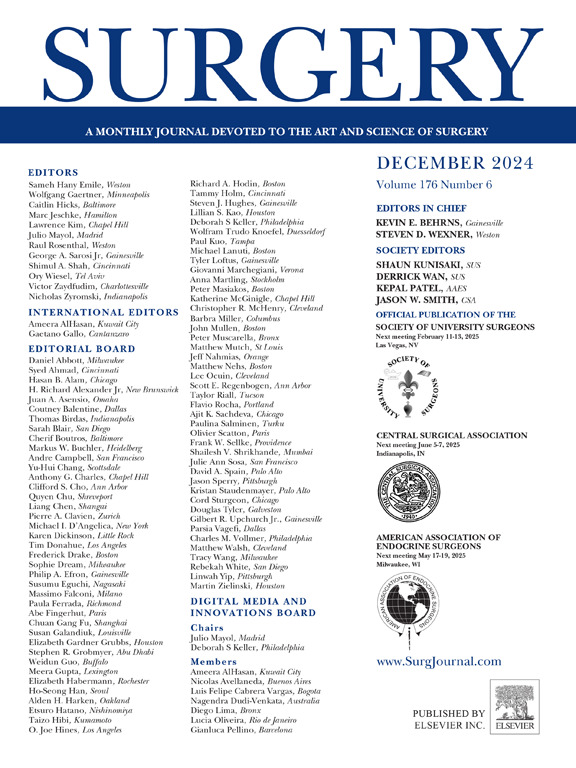Contemporary trends in practice patterns and clinical outcomes of thoracic endovascular aortic repair for nontraumatic thoracic aortic disease in the Vascular Quality Initiative
IF 3.2
2区 医学
Q1 SURGERY
引用次数: 0
Abstract
Introduction
The purpose of this analysis was to document longitudinal changes in thoracic endovascular aortic repair practice patterns and clinical outcomes, using data from the Vascular Quality Initiative.
Methods
All patients who underwent elective or nonelective thoracic endovascular aortic repair from 2015 to 2023 were reviewed (N = 23,532). The primary outcomes were in-hospital mortality and long-term survival. Secondary outcomes included in-hospital major complications and postoperative spinal cord ischemia. Procedures were classified into 3 time periods: early (2015–2017), middle (2018–2020), and late (2021–2023).
Results
Among elective procedures, a significant trend toward an increased proportion of dissection and penetrating aortic ulcer/intramural hematoma indications being treated over time was noted. Overall crude incidence of postoperative complications decreased significantly (25% vs 23% vs 21%; P < .001). In risk-adjusted analysis, incidence of any in-hospital complication declined for elective procedures, as well as nonelective cases (odds ratio, 0.93–0.96; 95% confidence interval, 0.92–0.98; P = .002). In particular, risk of spinal cord ischemia decreased after elective procedures (odds ratio, 0.96; 0.92–0.99; P = .03) but showed no change for nonelective cases despite an overall decrease in preoperative spinal drain use (41% vs 33% vs 23%; P < .001). Overall, unadjusted rates of in-hospital death did not vary significantly between time periods (5.8% vs 5.4% vs 5.4%; P = .45). However, in risk-adjusted analysis, in-hospital mortality risk decreased longitudinally after elective surgery (odds ratio, 0.94; 0.9–0.98; P = .001) but not for nonelective cases (P = .13). Cox regression analysis showed improved long-term survival for elective cases (hazard ratio, 0.96; 0.94–0.99; P = .02) but no change for nonelective procedures.
Conclusion
This analysis offers contemporary insights into thoracic endovascular aortic repair practice patterns and clinical outcomes, providing valuable benchmarking information for stakeholders focused on enhancing care delivery for this complex patient population.
求助全文
约1分钟内获得全文
求助全文
来源期刊

Surgery
医学-外科
CiteScore
5.40
自引率
5.30%
发文量
687
审稿时长
64 days
期刊介绍:
For 66 years, Surgery has published practical, authoritative information about procedures, clinical advances, and major trends shaping general surgery. Each issue features original scientific contributions and clinical reports. Peer-reviewed articles cover topics in oncology, trauma, gastrointestinal, vascular, and transplantation surgery. The journal also publishes papers from the meetings of its sponsoring societies, the Society of University Surgeons, the Central Surgical Association, and the American Association of Endocrine Surgeons.
 求助内容:
求助内容: 应助结果提醒方式:
应助结果提醒方式:


